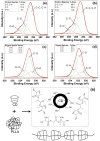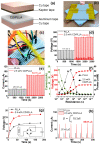Electrospun Cyclodextrin/Poly(L-lactic acid) Nanofibers for Efficient Air Filter: Their PM and VOC Removal Efficiency and Triboelectric Outputs
- PMID: 36772022
- PMCID: PMC9921114
- DOI: 10.3390/polym15030722
Electrospun Cyclodextrin/Poly(L-lactic acid) Nanofibers for Efficient Air Filter: Their PM and VOC Removal Efficiency and Triboelectric Outputs
Abstract
In this work, PLLA and CD/PLLA nanofibers were fabricated using electrospinning and utilized as a particulate matter (PM) and volatile organic compounds (VOCs) filter. The electrospun PLLA and CD/PLLA were characterized with various techniques, including SEM, BET, FTIR, XRD, XPS, WCA, DSC, tensile strength testing, PM and VOCs removal efficiency, and triboelectric performance. The results demonstrated that the best air filter was 2.5 wt%CD/PLLA, which performed the highest filtration efficiencies of 96.84 ± 1.51% and 99.38 ± 0.43% for capturing PM2.5 and PM10, respectively. Its PM2.5 removal efficiency was 16% higher than that of pure PLLA, which were contributed by their higher surface area and porosity. These 2.5 wt%CD/PLLA nanofibers also exhibited the highest and the fastest VOC entrapment. For triboelectric outputs, the 2.5 wt%CD/PLLA-based triboelectric nanogenerator provided the highest electrical outputs as 245 V and 84.70 μA. These give rise to a three-fold enhancement of electrical outputs. These results indicated that the 2.5 wt%CD/PLLA can improve surface charge density that could capture more PM via electrostatic interaction under surrounding vibration. Therefore, this study suggested that 2.5 wt%CD/PLLA is a good candidate for a multifunction nanofibrous air filter that offers efficient PM and VOC removal.
Keywords: PM; VOC; air filter; cyclodextrin; eco-friendly; electrospinning; nanogenerator; poly(L-lactic acid); triboelectric performance.
Conflict of interest statement
The authors declare no conflict of interest.
Figures










Similar articles
-
Electrospun silk nanofiber loaded with Ag-doped TiO2 with high-reactive facet as multifunctional air filter.RSC Adv. 2023 Aug 29;13(37):25729-25737. doi: 10.1039/d3ra04621d. eCollection 2023 Aug 29. RSC Adv. 2023. PMID: 37649664 Free PMC article.
-
Molecular entrapment of volatile organic compounds (VOCs) by electrospun cyclodextrin nanofibers.Chemosphere. 2016 Feb;144:736-44. doi: 10.1016/j.chemosphere.2015.09.029. Epub 2015 Sep 25. Chemosphere. 2016. PMID: 26408981
-
Triboelectric Nanogenerator Enhanced Nanofiber Air Filters for Efficient Particulate Matter Removal.ACS Nano. 2017 Jun 27;11(6):6211-6217. doi: 10.1021/acsnano.7b02321. Epub 2017 May 15. ACS Nano. 2017. PMID: 28489941
-
Natural Cellulose-Based Multifunctional Nanofibers for the Effective Removal of Particulate Matter and Volatile Organic Compounds.Nanomaterials (Basel). 2023 May 24;13(11):1720. doi: 10.3390/nano13111720. Nanomaterials (Basel). 2023. PMID: 37299623 Free PMC article.
-
Electrospinning of Nanofibrous Membrane and Its Applications in Air Filtration: A Review.Nanomaterials (Basel). 2021 Jun 6;11(6):1501. doi: 10.3390/nano11061501. Nanomaterials (Basel). 2021. PMID: 34204161 Free PMC article. Review.
Cited by
-
Electrospun Food Polysaccharides Loaded with Bioactive Compounds: Fabrication, Release, and Applications.Polymers (Basel). 2023 May 16;15(10):2318. doi: 10.3390/polym15102318. Polymers (Basel). 2023. PMID: 37242893 Free PMC article. Review.
-
Electrospun silk nanofiber loaded with Ag-doped TiO2 with high-reactive facet as multifunctional air filter.RSC Adv. 2023 Aug 29;13(37):25729-25737. doi: 10.1039/d3ra04621d. eCollection 2023 Aug 29. RSC Adv. 2023. PMID: 37649664 Free PMC article.
-
Electrospun Fibers from Biobased and Recycled Materials for Indoor Air Quality Enhancement.Molecules. 2025 Mar 8;30(6):1214. doi: 10.3390/molecules30061214. Molecules. 2025. PMID: 40141991 Free PMC article.
-
Novel mixed heterovalent (Mo/Co)Ox-zerovalent Cu system as bi-functional electrocatalyst for overall water splitting.Sci Rep. 2024 Feb 26;14(1):4601. doi: 10.1038/s41598-024-54934-9. Sci Rep. 2024. PMID: 38409208 Free PMC article.
References
-
- Zhang T., Mao W., Gao J., Song X., Li L., Sun X., Ding X., Li J., Zhai Y., Ma W. The effects of PM2. 5 on lung cancer-related mortality in different regions and races: A systematic review and meta-analysis of cohort studies. Air Qual. Atmos. Health. 2022;15:1523–1532. doi: 10.1007/s11869-022-01193-0. - DOI
-
- Li X., Liu X. Effects of PM2. 5 on Chronic Airway Diseases: A Review of Research Progress. Atmosphere. 2021;12:1068. doi: 10.3390/atmos12081068. - DOI
Grants and funding
LinkOut - more resources
Full Text Sources

